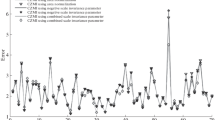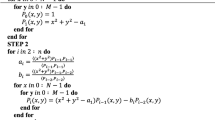Abstract
Orthogonal rotation invariant moments (ORIMs) are among the best region based shape descriptors. Being orthogonal and complete, they possess minimum information redundancy. The magnitude of moments is invariant to rotation and reflection and with some geometric transformation, they can be made translation and scale invariant. Apart from these characteristics, they are robust to image noise. These characteristics of ORIMs make them suitable for many pattern recognition and image processing applications. Despite these characteristics, the ORIMs suffer from many digitization errors, thus they are incapable of representing subtle details in image, especially at high orders of moments. Among the various errors, the image discretization error, geometric and numerical integration errors are the most prominent ones. This paper investigates the contribution and effects of these errors on the characteristics of ORIMs and performs a comparative analysis of these errors on the accurate computation of the three major ORIMs: Zernike moments (ZMs), Pseudo Zernike moments (PZMs) and orthogonal Fourier-Mellin moments (OFMMs). Detailed experimental analysis reveals some interesting results on the performance of these moments.



















Similar content being viewed by others
References
Abu Mostofa, Y.S.: Recognitive aspects of moment invariants. IEEE Trans Pattern Anal Mach Intell 6(6), 698–706 (1984)
Bhatia, A.B., Wolf, E.: On the circle polynomials of Zernike and related orthogonal sets. Proc. Camb. Philol. Soc. 50, 40–48 (1954)
Ghosal, S., Mehrotra, R.: Edge detection using orthogonal moment based operators. In: Proceedings of the 11th Image, Speech and Signal Analysis (IAPR), International Conference on Pattern Recognition, vol. 3, pp. 413–416 (1992)
Ghosal, S., Mehrotra, R.: Segmentation of range images on orthogonal moment based integrated approach. IEEE Trans. Robot. Autom. 9(4), 385–399 (1993)
Haddadnia, J., Ahmadi, M., Raahemifar, K.: An effective feature extraction method for face recognition. In: Proceedings of 2003 International Conference on Image Processing, Spain, vol. 3, pp. 917–920 (2003)
Hu, M.K.: Visual pattern recognition by moment invariants. IEEE Trans. Inf. Theory 8, 179–187 (1962)
Keys, R.G.: Cubic convolution interpolation for digital image processing. IEEE Trans. Acoust. Speech Signal Process. 29(6), 1153–1160 (1981)
Kotoulas, L., Andreadis, I.: Accurate calculation of image moments. IEEE Trans. Image Process. 16(8), 2028–2037 (2007)
Liao, S.X., Pawlak, M.: On image analysis by moments. IEEE Trans. Pattern Anal. Mach. Intell. 18, 254–266 (1996)
Liao, S.X., Pawlak, M.: On the accuracy of Zernike moments for image analysis. IEEE Trans. Pattern Anal. Mach. Intell. 20(12), 1358–1364 (1998)
Lin, H., Si, J., Abousleman, G.P.: Orthogonal rotation invariant moments for digital image processing. IEEE Trans. Image Process. 17(3), 272–282 (2008)
Pang, Y.H., Andrew, T.B.J., David, N.C.L., Hiew, F.S.: Palmprint verifications with moments. J. WSCG 12, 1–3 (2003)
Pawlak, M.: Image Analysis by Moments: Reconstruction and Computational Aspects. Oficyna Wydawnicza Politechniki Wroclawskiej, Wroclaw (2006). Available freely at the site http://www.dbc.wroc.pl/dlibra/docmetadata?id=1432&from=&dirids=1
Ping, Z.L., Sheng, Y.L.: Image description with Chebyshev-Fourier moments. Acta Opt. Sin. 19(9), 1748–1754 (2002)
Rajaraman, V.: Computer Oriented Numerical Methods, 3rd edn. Prentice Hall of India, New Delhi (2004)
Reichenbach, S.E., Geng, F.: Two-dimensional cubic convolution. IEEE Trans. Image Process. 12(8), 857–865 (2003)
Ren, H., Liu, A., Zou, J., Bai, D., Ping, Z.: Character reconstruction with radial harmonic Fourier moments. In: Proc. of the 4th Int. Conf. on Fuzzy Systems and Knowledge Discovery 2007 (FSKD07), vol. 3, pp. 307–310 (2007)
Sheng, Y., Shen, L.: Orthogonal Fourier Mellin moments for invariant pattern recognition. IEEE Trans. J. Opt. Soc. Am. 11(6), 1748–1757 (1994)
Singh, C., Pooja, S., Upneja, R.: On image reconstruction, numerical stability, and invariance of orthogonal radial moments and radial harmonic transforms. Pattern Recognit. Image Anal. 21(4), 663–676 (2011)
Singh, C., Pooja, S.: Improving image retrieval using combined features of hough transform and Zernike moments. Opt. Lasers Eng. 49(12), 1384–1396 (2011)
Singh, C., Upneja, R.: A computational model for enhanced accuracy of radial harmonic Fourier moments. In: World Congress of Engineering, London, U.K., pp. 1189–1194 (2012)
Singh, C., Upneja, R.: Accurate computation of orthogonal Fourier Mellin moments. J. Math. Imaging Vis. 44(3), 411–431 (2012)
Singh, C., Upneja, R.: Error analysis and accurate calculation of rotational moments. Pattern Recognit. Lett. 33, 1614–1622 (2012)
Singh, C., Upneja, R.: Fast and accurate method for high order Zernike moments computation. Appl. Math. Comput. 218, 7759–7773 (2012)
Singh, C., Walia, E.: Algorithms for fast computation of Zernike moments and their numerical stability. Image Vis. Comput. 29, 251–259 (2011)
Singh, C., Walia, E.: Computation of Zernike moments in improved polar configuration. IET Image Process. 3(4), 217–227 (2009)
Singh, C., Walia, E.: Fast and numerically stable methods for the computation of Zernike moments. Pattern Recognit. 43, 2497–2506 (2010)
Singh, C., Walia, E., Pooja, S., Upneja, R.: Analysis of algorithms for fast computation of pseudo Zernike moments and their numerical stability. Digit. Signal Process. 22(6), 1031–1043 (2012)
Singh, C., Walia, E., Upneja, R.: Accurate calculation of Zernike moments. Inf. Sci. 233(1), 255–275 (2013)
Teague, M.R.: Image analysis via the general theory of moments. J. Opt. Soc. Am. 70(8), 920–930 (1980)
Teh, C.H., Chin, R.T.: On image analysis by the methods of moments. IEEE Trans. Pattern Anal. Mach. Intell. 10(4), 496–513 (1988)
Walia, E., Singh, C., Goyal, A.: On the fast computation of orthogonal Fourier-Mellin moments with improved numerical stability. J. Real-Time Image Process. 7(4), 247–256 (2012)
Wee, C.Y., Paramseran, R.: On the computational aspects of Zernike moments. Image Vis. Comput. 25, 967–980 (2007)
Xin, Y., Liao, S., Pawlak, M.: Circularly orthogonal moments for geometrically robust image watermarking. Pattern Recognit. 40, 3740–3752 (2007)
Xin, Y., Liao, S., Pawlak, M.: Geometrically robust image watermark via pseudo Zernike moments. In: Proceedings of the Canadian Conference on Electrical and Computer Engineering, vol. 2, pp. 939–942 (2004)
Xin, Y., Pawlak, M., Liao, S.: Accurate calculation of moments in polar co-ordinates. IEEE Trans. Image Process. 16, 581–587 (2007)
Acknowledgements
The useful comments and suggestions of the anonymous reviewers to raise the standard of the paper are highly appreciated. The research fellowship awarded to one of the authors (Rahul Upneja) by the Council of Scientific and Industrial Research (C.S.I.R.), Govt. of India, is also highly acknowledged.
Author information
Authors and Affiliations
Corresponding author
Appendix
Appendix
1.1 A.1 Cubic Interpolation of Image Function
An image consisting of N×N pixels assumes that the pixel values f(i,k) are defined at the center of the pixel which occupies the area
and has the center at (x i ,y k ) as shown in Fig. 1(a). The cubic interpolation assumes that the discrete data, which is converted into a continuous function, must be defined at the crossing of the grids which are given the name ‘nodes’ for further reference. Let the coordinates of nodes be denoted by (X i ,Y k ), which are given by
The cubic interpolation method requires the discrete values of the function at locations (X i ,Y k ), for i,k,=0,1,…,N, whereas the pixels are defined at pixel centers (x i ,y k ),i,k=0,1,…,N−1. Thus for an N×N image, there are (N+1)×(N+1) nodes at which the discrete values are required. A simple solution to this problem is to define a discrete function which is obtained by taking the average of pixel values meeting at a given node. Mathematically, we can obtain g(i,k) as follows
where
After deriving g(i,k) the value of the image intensity can be obtained at a point (x,y)∈[x i ,y k ]×[x i+1,y k+1], i,k=0,1,…,N−1, as given below
where
with
The expressions u rl (x i ) and u sm (y k ) are given in [7]. The intensity function g(i,k) is derived for i,k=0,1,…,N as given by Eq. (33). However, Eq. (35) requires values for the extended grid which are determined by the procedure given in [7].
Rights and permissions
About this article
Cite this article
Singh, C., Upneja, R. Error Analysis in the Computation of Orthogonal Rotation Invariant Moments. J Math Imaging Vis 49, 251–271 (2014). https://doi.org/10.1007/s10851-013-0456-1
Published:
Issue Date:
DOI: https://doi.org/10.1007/s10851-013-0456-1




